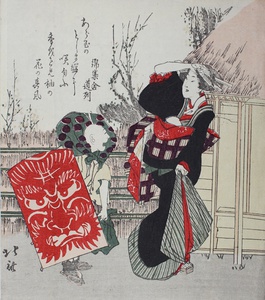| Method | Woodblock (nishiki-e) |
| Artist | After Totoya Hokkei (1780-1850) |
| Published | c.1890's |
| Dimensions | Kaku-Surimono [~7 x 8.5] |
| Notes |
Signature: False signature: Hokusai Refrence: Keyes, Roger. The Art of Surimono: Privately publised Japanese woodblock prints and books in the Chester Beatty Library, Dublin. Sotheby, London, 1985. No.66. A group C copy of an earlier Hokkei surimono. At the end of the 19th century, realizing their aesthetic value, a number of publishers decided to re-carve a selection of Edo period surimono designs. Printed in editions of 50 or 100, they were sold principally to Western tourists in Japan. Totoya Hokkei (1780-1850) was a Japanese artist best known for his prints in the ukiyo-e style. One of Hokusai's earliest and most gifted pupils, Hokkei was particularly renowned in the field of surimono. Before his initial training with Kanô Yôsen' in Korenobu, he worked as a fishmonger at Yotsuya Samegahashi, hence the unusual art surname of Totoya/Uoya (fish shop). Hokkei's first work appeared in 1799. He designed a number of surimono in the 1800s and 1810s, but he did not master the art of designing them until the late 1810s. Besides surimono and illustrations for poetry albums, Hokkei designed a few illustrations for popular fiction and some commercially published prints. Condition: Trimmed. Minor creasing to sheet. |
| Framing | mounted |
| Price | £200.00 |
| Stock ID | 51270 |

